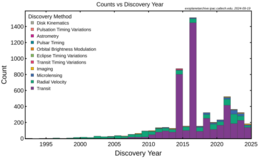|
NASA Exoplanet Archive
The NASA Exoplanet Archive is an online astronomical exoplanet catalog and data service that collects and serves public data that support the search for and characterization of extra-solar planets (exoplanets) and their host stars. It is part of the Infrared Processing and Analysis Center and is on the campus of the California Institute of Technology (Caltech) in Pasadena, CA. The archive is funded by NASA and was launched in early December 2011 by the NASA Exoplanet Science Institute as part of NASA's Exoplanet Exploration Program. In June 2019, the archive's collection of confirmed exoplanets surpassed 4,000.[1] (Compare: As of 14 January 2025, there are 5,819 confirmed exoplanets in 4,346 planetary systems, with 974 systems having more than one planet.[2]) The archive's data include published light curves, images, spectra and parameters, and time-series data from surveys that aim to discover transiting exoplanets. The archive also develops Web-based tools and services to work with the data, particularly the display and analysis of transit data sets from the Kepler mission and COnvection ROtation and planetary Transits (CoRoT) mission, for which the Exoplanet Archive is the U.S. data portal. Other astronomical surveys and telescopes that have contributed data sets to the archive include SuperWASP, HATNet Project, XO, Trans-Atlantic Exoplanet Survey and KELT. According to third-party web analytics provider SimilarWeb, the company's website has over 130,000 visits per month, as of January 2015.[3] Exoplanet Data ContentThe Exoplanet Archive contains objects discovered through all methods (radial velocity, transits, microlensing, imaging, astrometry, eclipse timing variations, and transit timing variations/TTV) that have publicly available planetary parameters, with a mass (or minimum mass) equal to or less than 30 Jupiter masses.[4] Exoplanet Archive Tools and Services In addition to providing access to large public data sets, the Exoplanet Archive has developed several tools to work with exoplanet and stellar host data.[6]
Transit Survey Data in the Exoplanet ArchiveThe Exoplanet Archive serves photometric time-series data from surveys that aim to discover transiting exoplanets, such as the Kepler Mission and CoRoT. The database provides access to over 22 million light curves from space and ground-based exoplanet transit survey programs, including:
The Exoplanet Archive offers search and filtering capabilities for exoplanet stellar and planetary properties, Kepler planetary candidates, and time series data sets. All data in the Exoplanet Archive are vetted by a team of astronomers and the original literature references are available. The Exoplanet Archive supports interactive visualization of images, spectra, and time series data and maintains its own stellar cross-identification to minimize ambiguity in multiple star components. See also
References
External links
|
||||||||||

